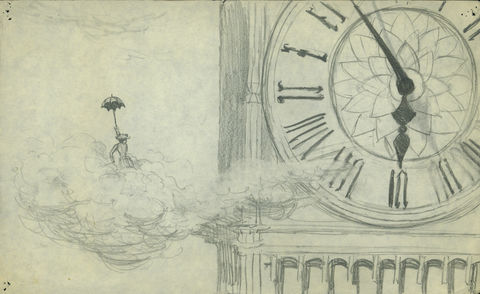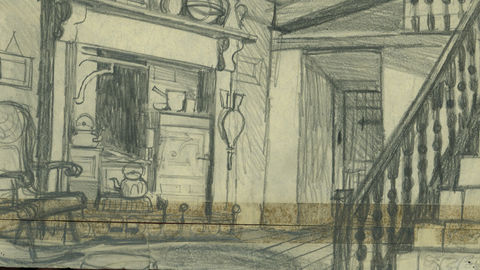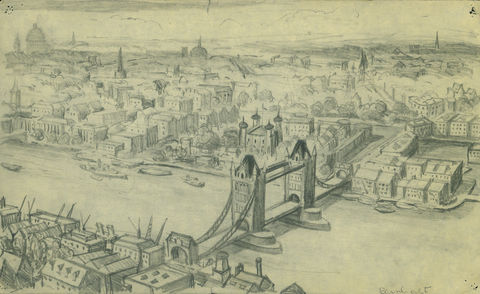Walt Disney was no stranger to London. Multiple visits to England between the 1930s and 1950s—often for on-set visits to his live-action films such as Treasure Island (1950), The Story of Robin Hood and his Merrie Men (1952), and The Sword and the Rose (1953)—had given him the opportunity to become well acquainted with its capital city.

It was during one short London stop-off in the summer of 1959 that Walt first met P. L. Travers, the author of the beloved Mary Poppins children’s books. After landing at Heathrow—then known as London Airport—with his wife Lillian, Walt went to speak with Travers face-to-face, with the sole intention of securing the rights to adapt Mary Poppins for the screen. Despite his best efforts over the course of two decades, Travers had repeatedly rejected Walt’s pleas.
“He decided to try and call Mrs. Travers and see whether his personal charm could win things over. That meeting clinched things—Walt Disney finally got the rights to Mary Poppins,” explained author Brian Sibley in the 2004 Disney home entertainment documentary featurette, Supercalifragilisticexpialidocious: The Making of Mary Poppins. When Walt left London and flew over to Dublin later that week for the premiere of the live-action Disney movie Darby O’Gill and the Little People (1959), his mission had been accomplished.
An English ensemble
Walt cast multiple English actors to star in Mary Poppins (1964)—including future Disney Legends Julie Andrews, Glynis Johns, and David Tomlinson—and also brought in a suite of creatives from “across the pond” to work on the film’s production. One such creative was future Disney Legend Peter Ellenshaw, a London-born artist who had previously worked with Walt on Treasure Island and 20,000 Leagues Under the Sea (1954), and had even lent his artistic talents to the now-famous eight-foot-wide map painting that Walt used to introduce the Disneyland project to his television audience.
Ellenshaw’s specialty was matte painting, a technique used in film to create detailed and realistic backgrounds. Walt was fascinated by the way matte painting reduced the need for his movies to be produced on location—he had been able to film Treasure Island entirely in England thanks in part to Ellenshaw’s work. “He’d always be telling people here [in Hollywood] that he had a young artist in England who’d worked on Treasure Island and he [Ellenshaw] made it so that you didn’t have to go to some island—he could make it look as though it’s in the island by painting these things,” Ellenshaw later shared.
For Mary Poppins, the challenge was not to turn England into somewhere with sunshine and palm trees—completely the opposite, in fact! At The Walt Disney Studios lot in Burbank, Ellenshaw was tasked with creating 100 matte paintings that could convincingly depict the city of London. But instead of trying to paint the English capital like a photograph, Ellenshaw’s London was dreamlike and hazy, made up of soft colors and whimsical clouds. “You didn’t have to make it look so real that it didn’t look fanciful,” he explained.
Still, there were some tricks of the trade that Ellenshaw used to add authenticity to his work – such as tiny golden lights that would make the cityscape glisten: “I painted a view of the city of London in the late afternoon, and behind the glass made little holes in the paint so that we could put lights back on it and the lights would all come on gradually all over the city, or appear to.”
Designing, building, decorating

With the backdrops of London left in Ellenshaw’s capable hands, Walt’s next task was to make sure the physical set design for Mary Poppins was equally magnificent. He brought set decorators Emile Kuri and Hal Gausman on board to work alongside art directors Carroll Clark and William H. Tuntke in bringing Cherry Tree Lane to life.
The trouble with constructing an entire street of large Georgian-style houses was that vital sound stage space would quickly be lost —and so, the team used forced perspective tricks to subtly “shrink” their Cherry Tree Lane façades. Tuntke later explained how this had been achieved: “Where Mary Poppins made her entrance and all the way up to the Banks’ house, I built the set full-scale. The Banks’ house itself was 7/8ths scale. The next house was 3/4ths scale. The next house was half-scale. And the next one was 1/4 scale. And you would see all these houses receding. I got real cherry trees to line the street, and I had all the greensmen to put twigs on it and paper cherry blossoms; there were eighteen trees in all, and they were built to decreasing scale as well.”
English costume and set designer Tony Walton—then-husband of a young Julie Andrews—had been personally invited to join the Mary Poppins team by Walt, who had wanted an English designer on his staff. Walton’s focus was primarily on costuming—such as Bert’s striped “Jolly Holiday” jacket and Mary’s iconic daisy and cherry decorated black hat—but he also made valuable contributions to the film’s set design. He remembered watching MGM’s An American in Paris (1951) as a young boy and feeling irritated by the fake, flat cobblestone streets he saw on-screen. Keeping this in mind, he insisted to Walt that Cherry Tree Lane be built in a more realistic fashion – with authentic-looking paving, curbs and walls, as well as an S-shaped curve to the street itself.
Perhaps inevitably, Walt’s transatlantic team didn’t always see eye-to-eye when it came to the authenticity of the Mary Poppins set. “Peter [Ellenshaw] thought [the interiors of the Banks house] didn’t look English enough,” Emile Kuri later reminisced. “Well, Walt came down and looked at the set, and he said, ‘If Emile did it, it looks fine to me.’ And Peter was so damn mad at me. He could have killed me.”
Luckily, Walt’s trust in Kuri paid off—audiences and critics alike were enchanted by the Banks family’s manmade abode. One early review of the movie—from the Hollywood Reporter’s James Powers—gave a special mention to the detail and care that had been put into Mary Poppins’ set design. “They have created a rich atmosphere of security and a free flow of fantasy, simultaneously,” an impressed Powers wrote.
A love letter to London

Walt’s soundstage replica of London might not have been the real deal, but in many ways, that made its existence even more impressive. He and his team created a city from scratch, using their collective ingenuity to convince theatergoers that the streets, rooftops and buildings they saw on the screen in front of them were authentically English. The film went on to premiere on June 18, 1964, and would receive a record 13 Academy Award® nominations, including Art Direction and Costume Design. It would go on to win five: Actress, Film Editing, Score, Song, and Special Visual Effects.
“Walt took his all of his little bag of tricks that he developed over 35 years and put them into this picture,” said Disney Legend, composer Richard Sherman as he fondly recalled his time spent working on the movie. And with Mary Poppins still regarded as one of Disney’s crowning achievements exactly 60 years on, the cinematic culmination of Walt’s “little bag of tricks” rightfully remains as celebrated as ever.

–Sophie Jo
Sophie Jo is an author and long-time Disney fan from England, who's never happier than when she's in a Doom Buggy. Her main focus for The Walt Disney Family Museum blog is Walt's 1950s/60s Disneyland.
Image Sources*:
-
Disney Studio Artist, bird’s eye view of London storyboard drawing, Mary Poppins (1964); collection of the Walt Disney Family Foundation; © Disney
-
Disney Studio Artist, Mary Poppins on a cloud storyboard drawing, Mary Poppins (1964); collection of the Walt Disney Family Foundation; © Disney
-
Disney Studio Artist, Kitchen scene, Mary Poppins (1964); collection of the Walt Disney Family Foundation; © Disney
